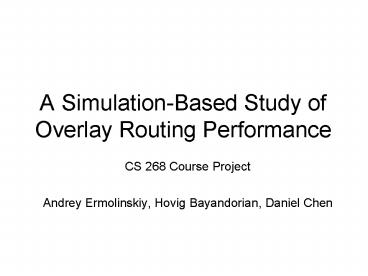A SimulationBased Study of Overlay Routing Performance - PowerPoint PPT Presentation
1 / 13
Title:
A SimulationBased Study of Overlay Routing Performance
Description:
To evaluate the performance of a given choice of O, compute the topology stretch. ... Gaussian with negatively correlated weights produces stretch bounded away from 1. ... – PowerPoint PPT presentation
Number of Views:32
Avg rating:3.0/5.0
Title: A SimulationBased Study of Overlay Routing Performance
1
A Simulation-Based Study of Overlay Routing
Performance
- CS 268 Course Project
- Andrey Ermolinskiy, Hovig Bayandorian, Daniel Chen
2
Problem Statement
- The current Internet infrastructure is highly
resistant to change new network-layer
functionality is difficult to implement and
costly to deploy. - Standard Internet routing protocols (BGP, OSPF)
generally fail to deliver low- latency and
high-throughput routing paths. - Coarse-grained routing metrics (e.g., hop count)
- BGP policies
- Lack of economic incentives to provide
performance-based routing - Overlay networks offer an alternative method for
deploying new routing functionality - Set up an application-level logical network.
- Deploy a higher-level routing protocol that
routes packets according to any desired routing
metric. - Question 1 Given an alternative routing protocol
that implements an arbitrary routing metric, to
what extent can an overlay-based solution
approximate a network-layer deployment? - Question 2 What is the best way to select
overlay nodes?
3
Approach
- Assume the existence of two distinct routing
metrics WB (base), WO (overlay) and two
routing protocols RB, RO that implement
shortest path routing for WB and WO ,
respectively. - Model the topology as a dualweighted graph
- G (V, WB, WO).
- RB is the default routing algorithm in G, but a
subset of nodes O implements RO via an overlay
mechanism.
CO(V1-V2-V5-V6) 17
CO(V1-V3-V2-V4-V5-V6) 9
4
Approach
- To evaluate the performance of a given choice of
O, compute the topology stretch.
Logical overlay subgraph
Dual-weighted topology graph
Stretch(v1, v6) 11 / 9
O v2, v4, v5
Stretch(v1, v6) 9 / 9 1 (Optimal Path)
O v2, v3 , v4, v5
5
Results Distribution of Stretch Values
- Exhaustive search through the space of all
subsets of nodes in two uniform random topologies
from ?(N, p),
N 20, p 0.5
N 20, p 0.1
- Only 2 overlay nodes are required to achieve
optimal routing. - 90 of all overlays of size 11 or more achieve
stretch value of 1.03.
- 11 overlay nodes are required to achieve optimal
routing.
6
Average Stretch in Large Random Topologies
- Estimated average stretch for three uniform
random topologies drawn from ?(1000, p). - A large fraction of the maximum achievable
improvement lies with small selections of overlay
nodes
For p 0.1 100 overlay nodes provide 66.0 of
the achievable improvement. For p 0.5 100
overlay nodes provide 86.4. For p 0.9 100
overlay nodes provide 89.9.
7
Choice of the Topology Model
Uniform random from ?(1050, 0.0196).
Waxman (N 1050, a 0.086, ß 0.2).
Transit-stub 1 transit domain with 50 nodes 1
stub domain per transit node 20 nodes per stub
domain, each domain is a complete subgraph.
8
Alternative Weight Distributions
- Edge weights WB(vi, vj) and WO(vi,vj) were drawn
from a bivariate Gaussian distribution.
Positively correlated weights
Negatively correlated weights
- Gaussian with negatively correlated weights
produces stretch bounded away from 1. - Distribution does not appear to affect the shape
of the curve.
9
Computational Complexity of Optimal Overlay Search
OPTOVERLAY(G, k) Given a dual-weighted graph G,
find an optimal overlay of size at most k if one
exists.
- We can show that OPTOVERLAY is NP-complete
- The proof involves reducing 3-SAT to the decision
problem Does there exist an optimal overlay of
size k?
The figure to the left illustrates a sample
construction that corresponds to the Boolean
formula (x1 x2 x3) (x2 x3 x4)
10
Node Selection Heuristics
- We investigated several node selection
heuristics, including - Selecting a random subset
- Selecting the best of k random subsets
- Degree sorting
- selecting nodes with the highest degree
- Importance sorting
- selecting the most important nodes
- Node importance is defined as the number of
pairwise shortest paths in the topology to which
the node belongs. - Structure-aware selection (for transit-stub
topologies) - Selecting only the transit nodes
- Selecting only the periphery nodes
- Selecting one node from each domain, etc.
11
Heuristics Results
- Transit-stub topology
- 4 transit domains
- 25 nodes per transit domain
- 1 stub domain per transit node
- 9 nodes per stub domain
- Waxman topology
- N 1050, a 0.086, ß 0.2
- Degree sorting works best.
- 1 node from every stub domain works best.
12
Summary and Conclusions
- Overlay networks work well on a range of
simulated topology models and most of the
improvement can be achieved with a fairly small
selection of overlay nodes. - Picking an optimal overlay is hard, but degree
sorting and other heuristics provide efficient
approximations. - Random node selection works surprisingly well.
13
Heuristics Results































